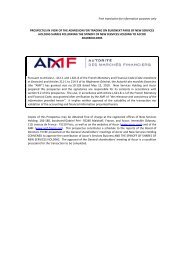Code of Conduct for the Protection of Children from Sexual ...
Code of Conduct for the Protection of Children from Sexual ...
Code of Conduct for the Protection of Children from Sexual ...
You also want an ePaper? Increase the reach of your titles
YUMPU automatically turns print PDFs into web optimized ePapers that Google loves.
The Agenda <strong>for</strong> Action recommends <strong>the</strong> following ways <strong>of</strong> combating <strong>the</strong> commercial sexual<br />
exploitation <strong>of</strong> children:<br />
♦ Co-operation between countries and various sectors <strong>of</strong> society<br />
♦ Mobilising <strong>the</strong> tourist industry and <strong>the</strong> business world so that <strong>the</strong>ir facilities and<br />
networks are not used <strong>for</strong> child sex trade<br />
♦ Criminalising <strong>the</strong> commercial sexual exploitation <strong>of</strong> children<br />
♦ Actions to ensure that laws, plans and programmes against child sex trade are<br />
established and carried out<br />
♦ Establishing special units within <strong>the</strong> police<br />
♦ Recovery and rehabilitation <strong>of</strong> children<br />
♦ Preventive measures in <strong>the</strong> <strong>for</strong>m <strong>of</strong> education and in<strong>for</strong>mation<br />
(Declaration and Agenda <strong>for</strong> Action adopted during <strong>the</strong> World Congress against <strong>the</strong><br />
Commercial <strong>Sexual</strong> Exploitation <strong>of</strong> <strong>Children</strong>, Stockholm, August 1996)<br />
The tourism industry is represented in most <strong>of</strong> <strong>the</strong> world’s cities and covers a wide and<br />
important network. The tourism industry provides visitors and, hence, potential child sextourists<br />
with access to its infrastructure: transport, accommodation and services.<br />
Even though <strong>the</strong> largest portion <strong>of</strong> <strong>the</strong> child sex trade caters to local clients, <strong>the</strong><br />
incidence <strong>of</strong> tourists <strong>from</strong> industrialized countries travelling to developing countries<br />
to purchase sexual services <strong>of</strong> local children and women is a very visible part <strong>of</strong> <strong>the</strong><br />
problem <strong>of</strong> child-sexual exploitation.<br />
Pr<strong>of</strong>essionals working within <strong>the</strong> tourism industry have unique possibilities to<br />
observe, increase awareness <strong>of</strong> and report on <strong>the</strong> commercial sexual exploitation <strong>of</strong><br />
children.<br />
4. The UN Convention on <strong>the</strong> Rights <strong>of</strong> <strong>the</strong> Child<br />
Since 1989, 191 <strong>of</strong> <strong>the</strong> world’s countries have adopted <strong>the</strong> United Nations Convention on <strong>the</strong><br />
Rights <strong>of</strong> <strong>the</strong> Child. This Convention contains 54 articles, all <strong>of</strong> which are directed towards<br />
protecting children. The welfare <strong>of</strong> children is fundamental to this Convention. ”In all<br />
measures concerning children, <strong>the</strong> welfare <strong>of</strong> children shall be a primary concern” (Article 3,<br />
United Nations Convention on <strong>the</strong> Rights <strong>of</strong> <strong>the</strong> Child.) Several <strong>of</strong> <strong>the</strong> articles specify various<br />
ways to protect children against commercial sexual exploitation. This is particularly true <strong>of</strong><br />
Article 34, as well as <strong>of</strong> Articles 35, 36 and 37. All United Nations Conventions are legally<br />
binding, which means that those countries that have ratified any UN Convention have<br />
agreed to adhere to <strong>the</strong> provisions <strong>of</strong> <strong>the</strong> Convention.<br />
The complete text <strong>of</strong> Article 34 <strong>of</strong> <strong>the</strong> UNCRC reads:<br />
”State parties undertake to protect <strong>the</strong> child <strong>from</strong> all <strong>for</strong>ms <strong>of</strong> sexual exploitation and sexual<br />
abuse. For <strong>the</strong>se purposes state parties shall in particular take all appropriate, national,<br />
bilateral and multilateral measures to prevent;<br />
(a) <strong>the</strong> inducement or coercion <strong>of</strong> a child to engage in any unlawful sexual activity;<br />
(b) <strong>the</strong> exploitative use <strong>of</strong> children in prostitution or o<strong>the</strong>r unlawful sexual practices;<br />
(c) <strong>the</strong> exploitative use <strong>of</strong> children in pornographic per<strong>for</strong>mances and materials.”<br />
5. The UN World Tourism Organization (UNWTO/OMT)<br />
UNWTO is <strong>the</strong> leading international organization in <strong>the</strong> field <strong>of</strong> tourism. It<br />
has 141 member States as well as 304 Affiliate Members representing <strong>the</strong><br />
operational sector. With its headquarters in Madrid, UNWTO is an<br />
intergovernmental agency entrusted by <strong>the</strong> UN with <strong>the</strong> promotion and<br />
8

















